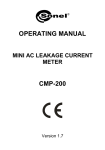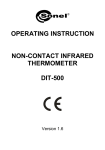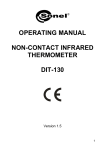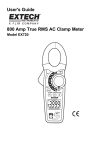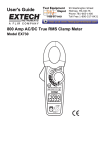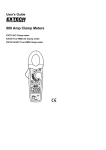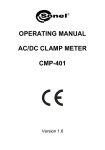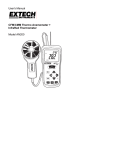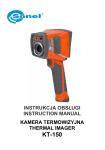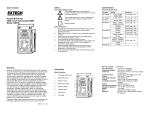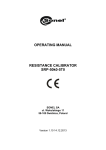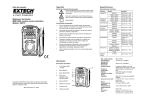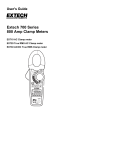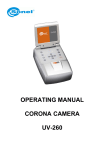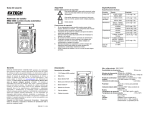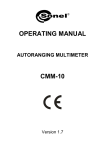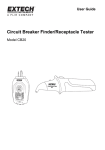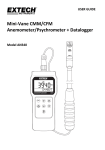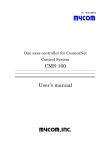Download CMP-1006 ins obs v1.4 GB
Transcript
OPERATING INSTRUCTION AC/DC DIGITAL CLAMP METER CMP-1006 Version 1.4 1 2 INTRODUTION...................................................... 3 SAFETY ................................................................... 4 2.1 3 INTERNATIONAL SAFETY SYMBOLS ...........................................6 PREPARATION OF THE METER FOR OPERATION ........................................................... 6 FUNCTIONAL DESCRIPTION............................ 7 4 4.1 MEASUREMENT SOCKETS AND ELEMENTS OF SELECTION OF THE MEASUREMENT FUNCTION....................................................................7 4.2 LCD DISPLAY .............................................................................8 4.3 TEST LEADS ................................................................................9 5 MEASUREMENTS................................................. 9 5.1 5.2 5.3 5.4 5.5 5.6 5.7 5.8 5.9 5.10 5.11 5.12 6 7 8 9 10 AC/DC CURRENT MEASUREMENTS ............................................9 AC AND DC VOLTAGE MEASUREMENTS ...................................11 RESISTANCE MEASUREMENTS ..................................................11 FREQUENCY OR % DUTY CYCLE MEASUREMENTS ....................12 TEMPERATURE MEASUREMENTS ..............................................12 CONTINUITY MEASUREMENTS .................................................13 DIODE MEASUREMENTS ...........................................................13 DATA HOLD FUNCTION .........................................................14 DC ZERO ................................................................................14 INRUSH FUNCTION ...................................................................14 LCD BACKLIGHT BUTTON .......................................................15 AUTOMATIC POWER OFF.........................................................15 BATTERY REPLACEMENT.............................. 15 CLEANING AND MAINTENANCE .................. 16 STORAGE ............................................................. 16 DISMANTLING AND UTILIZATION .............. 16 ATTACHMENTS.................................................. 17 10.1 TECHNICAL DATA .....................................................................17 10.2 STANDARD EQUIPMENT ............................................................19 10.3 MANUFACTURER ......................................................................19 2 1 Introdution We appreciate your having purchased our digital clamp meter. The CMP-1006 meter is a modern, high-quality measuring device, which is easy and safe to use. Please acquaint yourself with the present manual in order to avoid measuring errors and prevent possible problems related to operation of the tester. In the present manual we apply three kinds of warnings. These are texts in frames, which describe possible dangers both for the user and the meter itself. The messages starting from the word ‘WARNING:’ describe situations which imply a risk for life or health should the recommendations presented in the present manual not be observed. The word ‘ATTENTION!’ introduces a description of a situation where non-observance of the recommendations presented in the present manual may imply damage for the meter. Indications of possible problems are preceded by the word ‘Attention:’. WARNING: Before using the instrument acquaint yourself with the present manual and observe the safety regulations and recommendations specified by the manufacturer. WARNING: The purpose of the CMP-1006 meter is to realise clamp measurements of AC/DC current and also to realise AC/DC voltage, resistance, frequency and temperature measurements. Using the meter in a manner which does not comply with the recommendations specified in the present manual may lead to its damage and constitutes a source of a serious risk for the user. 3 WARNING: The CMP-1006 meter may be operated solely by qualified and properly authorised personnel for work at electric installations. Using the tester by unauthorised personnel may lead to its damage and constitutes a source of a serious risk for the user. 2 Safety In order to guarantee proper operation and correctness of the obtained results it is necessary to observe the following recommendations: • Before commencing operation of the meter please acquaint yourself thoroughly with the present manual, • The instrument should be operated solely by properly qualified personnel, who also must be trained regarding the industrial safety regulations, • Use great care when making measurements if the voltages are greater than 20VAC rms or 40VDC. These voltages are considered a shock hazard, • Always discharge capacitors and remove power from the device under test before performing Diode, Resistance or Continuity tests, • Before use for non-contact AC voltage measurements, always test the voltage detector on a known live circuit to verify proper operation, • It is prohibited to operated the meter: ⇒ If it is damaged and completely or partially out of order, ⇒ If the insulation of the test leads has been damaged, ⇒ If it has been stored for an excessive period of time in inadequate conditions (e.g. if it is humid), • Set function switch to the appropriate position before measuring, • When measuring volts do not switch to current/resistance modes, 4 • • • • Do not measure current on a circuit whose voltage exceeds 600V, When changing ranges always disconnect the test leads from the circuit under test, If the equipment is used in a manner not specified by the manufacturer, the protection provided by the equipment may be impaired, Repairs must be realised solely by an authorised service workshop. ATTENTION! Input Limits Function A DC, A AC V DC, V AC Resistance, Frequency, Diode Test Temperature (°C/°F) Maximum Input 1000A DC/AC 600V DC/AC 250V DC/AC 60V DC, 24V AC WARNING: Do not realise measurements with wet hands. WARNING: Do not realise measurements in environments in which there are inflammable gases. Otherwise operation of the meter under such conditions may cause sparking and explosion. 5 ATTENTION! Do not exceed the maximum allowable input range of any function. Do not apply voltage to meter when resistance function is selected. Set the function switch OFF when the meter is not in use. Remove the battery if meter is to be stored for longer than 60 days. 2.1 International Safety Symbols This symbol, adjacent to another symbol or terminal, indicates the user must refer to the manual for further information. This symbol, adjacent to a terminal, indicates that, under normal use, hazardous voltages may be present Double insulation 3 Preparation of the meter for operation Before measurements commence, it is necessary to realise the following actions: • Make sure the conditions of the batteries or accumulators permit to realise measurements, • Make sure the casing of the meter and the insulation of the test leads are not damaged, • Insert the black test lead into the negative COM terminal and the red test lead into the V·Ω· oC· oF·Hz positive terminal. WARNING: Connection of inappropriate or damaged test leads constitutes a risk of an electric shock with a dangerous voltage. 6 4 Functional description 4.1 Measurement sockets and elements of selection of the measurement function 1 A 2 A 6 3 4 DC AC ¡C ã ¡ã F A mV kM 5 1. Current clamp 7 2. Clamp opening trigger 3. Control buttons: a. Backlight b. Inrush / Mode c. Maks. / Min. d. Data Hold e. Hz / % / DC Zero 4. Backlit LCD Display 5. COM negative input jack for black test lead 6. Rotary function switch 7. V·Ω Ω ·°C·°F·Hz positive input jack for red lead 4.2 LCD display HOLD - Data Hold Minus sign - Negative reading display 0 do 6600 - Measurement display digits DC ZERO - DCA Zero MAKS/MIN - Maximum/Minimum INRUSH - Inrush Current AUTO - Auto Range mode DC/AC - Direct Current / Alternating Current - Low battery mV lub V 8 - Milli-volts or Volts (Voltage) Ω - Ohms (Resistance) A - Amperes (Current) F - Farad (Capacitance) Hz - Hertz (Frequency) o - Fahrenheit and Celsius units (Temperature) F i oC n, m, µ, M, k - Unit of measure prefixes: nano, milli, micro, mega, and kilo ·))) - Continuity test - Diode test 4.3 Test leads The manufacturer guarantees correct measurement indications provided original test leads are used. WARNING: Connection of inadequate test leads constitutes a risk of electric shock with a dangerous voltage or may be a cause of measurement errors. 5 Measurements It is recommended to get acquainted thoroughly with the contents of the present chapter since it describes the measurement systems, the manner of realisation of measurements and the basic principles of interpretation of the results. Set the function select switch to the OFF position when the meter is not in use. 5.1 AC/DC current measurements WARNING: Do not measure current on a circuit whose voltage exceeds 600V AC. Do not take current readings on circuits where the maximum current potential is not known. Do not exceed the 9 maximum allowable input range while measuring current. WARNING: Do not realise measurements if the battery compartment is open. WARNING: Do not commence measurements if the test leads are connected to the meter. In order to realise a measurement of current, it is necessary to realise the following actions: • Set the Function switch to the 1000A or 660A range. If the approx. range of the measurement is not known, select the highest range then move to the lower ranges if necessary, • Press the DC ZERO button to zero the meter display, • Press the trigger to open jaw. Fully enclose only one wire. For optimum results, center the wire in the jaw, • Read the result of the measurement on the display. Attention: During measurements of the current make sure the clamp is properly placed. Otherwise the results of the measurements will not be exact. The most exact result we will get if the wire is placed in the middle of clamp. 10 5.2 AC and DC voltage measurements WARNING: Do not realise measurements if the battery compartment is open. In order to realise a measurement of AC or DC voltage, it is necessary to realise the following actions: • Insert the black test lead into the negative COM terminal and the red test lead into the positive V·Ω Ω ·°C·°F·Hz terminal, • Set the function switch to the V Hz position, • Use the MODE button to select AC or DC Voltage, • Connect the test leads in parallel to the circuit under test, • Read the voltage measurement on the LCD display. 5.3 Resistance measurements WARNING: Measurements must not be realised in live circuits. Capacitors must be discharged. WARNING: Do not realise measurements if the battery compartment is open. In order to realise a measurement of the resistance it is necessary to realise the following actions: • Insert the black test lead into the negative COM terminal and the red test lead into the V·Ω Ω ·°C·°F·Hz positive terminal, • Set the function switch to the Ω •))) position, • Touch the test probe tips across the circuit or component under test; it is best to disconnect one side of the device under 11 • 5.4 test so the rest of the circuit will not interfere with the resistance reading, Read the resistance on the LCD display. Frequency or % duty cycle measurements In order to realise frequency or % duty cycle measurement it is necessary to realise the following actions: • Insert the black test lead banana plug into the negative COM jack and the red test lead banana plug into the V·Ω Ω ·°C·°F·Hz positive jack, • Set the function switch to the V Hz position, • Press the Hz/% button to select the Frequency (Hz) or Duty cycle (%)function, • Touch the test probe tips across the circuit under test, • Read the Frequency value on the display, • Duty cycle measurement: When the duty cycle is less than 10.0%, the LCD panel shows UL. When the duty cycle is more than 94.9%, the LCD panel shows OL, • The display will indicate the proper decimal point and value, • Press the HZ/% button again to return to the voltage mode. 5.5 Temperature measurements In order to realise temperature measurement it is necessary to realise the following actions: • Set the function switch to the Temp position, • Insert the Temperature Probe into the negative COM and the V·Ω Ω ·°C·°F·Hz positive jacks, observing polarity, • Touch the Temperature Probe head to the device under test. Continue to touch the part under test with the probe until the reading stabilizes, • Read the temperature on the display. The digital reading will indicate the proper decimal point and value, • Use the MODE button to select oF or oC. 12 WARNING: To avoid electric shock, be sure the thermocouple has been removed before changing to another measurement function. 5.6 Continuity Measurements WARNING: Measurements must not be realised in live circuits. Capacitors must be discharged. WARNING: Do not realise measurements if the battery compartment is open. In order to realise continuity test it is necessary to realise the following actions: • Insert the black test lead into the negative COM terminal and the red test lead into the V·Ω Ω ·°C·°F·Hz positive terminal, • Set the function switch to the Ω •))) position, • Use the MODE button to select continuity “•)))”. The display icons will change when the MODE button is pressed, • Touch the test probe tips across the circuit or component under test, • If the resistance is < 40Ω, a tone will sound. 5.7 Diode Measurements In order to realise diode test it is necessary to realise the following actions: • Insert the black test lead banana plug into the negative COM jack and the red test lead banana plug into the V·Ω Ω ·°C·°F·Hz positive jack, 13 • • • • Turn the function switch to Ω •))) position. Use the MODE button to select the diode function if necessary (diode symbol will appear on the LCD when in Diode test mode), Touch the test probe tips to the diode or semiconductor junction under test. Note the meter reading, Reverse the test lead polarity by reversing the red and black leads. Note this reading, The diode or junction can be evaluated as follows: ⇒ If one reading displays a value (typically 0.400V to 0.900V) and the other reading displays OL, the diode is good; ⇒ If both readings display OL the device is open; ⇒ If both readings are very small or ‘0’, the device is shorted. 5.8 DATA HOLD Function To freeze the LCD reading, press the HOLD button. While data hold is active, the HOLD icon appears on the LCD. Press the HOLD button again to return to normal operation. 5.9 DC ZERO The DC ZERO is a relative feature and can be used in a measurement of DC current. • Press the DC ZERO button to zero the display. “ZERO” will appear in the display. The displayed reading is now the actual value less the stored “zero” value; • To exit this mode, press and Hold the ZERO button until “ZERO” is no longer in the display. 5.10 Inrush Function The Inrush current function for AC current measurement to detect the starting-up current of a motor. In ACA modes, press INRUSH button will force meter to enter INRUSH mode. Then LCD Displays ”- - - -” until the motor starting up an being detected. The detection will be done only one time and the output reading will be hold. To exit INRUSH mode, press INRUSH button more than one second. 14 5.11 LCD Backlight Button The LCD is equipped with backlighting for easier viewing, especially in dimly lit areas. Press the backlight button to turn the backlight on. Press again to turn the backlight off. Note that the meter does have an auto power off feature as described below. 5.12 Automatic Power OFF In order to conserve battery life, the meter will automatically turn off after approximately 25 minutes. To turn the meter on again, turn the function switch to the OFF position and then to the desired function position. 6 Battery replacement The CMP-1006 meter is supplied by means of one 9V battery. It is recommended to use alkaline battery. Attention: When making measurements with a battery's mnemonic on, one must take into account additional indefinite measurement uncertainty or unstable working of the meter. WARNING: Should the test leads be left in the sockets during replacement of the battery, there might be a risk of electric shock with a dangerous voltage. In order to replace the battery it is necessary to do the following: • Remove the Phillips head screw that secures the rear battery door, • Open the battery compartment, • Replace the 9V battery, • Secure the battery compartment. 15 7 Cleaning and maintenance The casing of the meter may be cleaned with a soft, damp cloth using all-purpose detergents. Do not use any solvents or cleaning agents which might scratch the casing (powders, pastes, etc.). The electronic system of the meter does not require maintenance. 8 Storage In the case of storage of the device, the following recommendations must be observed: • Disconnect all the test leads from the meter, • Make sure the meter and its accessories are dry, • In the case the meter is to be stored for a prolonged period of time, the battery must be removed from the device. 9 Dismantling and utilization Worn-out electric and electronic equipment should be gathered selectively, i.e. it must not be placed with waste of another kind. Worn-out electronic equipment should be sent to a collection point in accordance with the law of worn-out electric and electronic equipment. Before the equipment is sent to a collection point, do not dismantle any elements. Observe the local regulations concerning disposal of packages, worn-out batteries and accumulators. 16 10 Attachments 10.1 Technical data „m.v.” means measured value of standard Function Range & Resolution AC Current True RMS (45 Hz to 65 Hz) 660.0A 1000A ±(2.5% m.v. + 8 digits) 660.0A ±(2.5% m.v. + 5 digits) 1000A ±(2.8% m.v. + 8 digits) DC Current Basic Accuracy ±(2.8% m.v. + 8 digits) 6.600V DC Voltage 66.00V ±(1.5% m.v. + 3 digits) 600.0V AC Voltage True RMS (45 Hz to 65 Hz) 6.600V 66.00V ±(1.8% m.v. + 5 digits) 600.0V 660.0Ω ±(1.0% m.v. + 4 digits) 6.600KΩ Resistance 66.00KΩ ±(1.5% m.v. + 2 digits) 660.0KΩ Frequency 6.600MΩ ±(2.5% m.v. + 3 digits) 66.0MΩ ±(3.5% m.v. + 5 digits) ±(1.2% m.v. + 2 digits) Sensitivity: 30…5kHz:10Vrms min. 5kHz…15kHz: 40Vrms 0,660…6,599kHz min. 30,0…659,9Hz 17 6,60…15,00kHz @ 20% to 80% duty cycle 10.0…94.9% unspecificated Pulse width: 100µs…100ms, Frequency: 30Hz…15kHz; Sensitivity: 30…5kHz:10Vrms min. 5kHz…15kHz:40Vrms min. Duty Cycle Temperature (probe accuracy not included) -20 to 760°C o -4 do 1400 F ±(3.0% m.v. + 5 °C) ±(3.0% m.v. + 9 °F) Other technical data: a) b) c) d) e) f) g) h) i) j) k) l) m) n) o) p) q) r) 18 Measurement category ..........III 600V according to EN 61010-1 Clamp jaw opening………………....34mm (1.34") approximately Internal diameters of clamp...…….………36x52mm (1,42x2,05”) Display……………………………………6600 counts backlit LCD Continuity check…………..threshold 40Ω; Test current < 0.5mA Diode test……………………………test current of 0.3mA typical; open circuit voltage < 3VDC typical Low Battery indication…………………………..‘BAT’ is displayed Over-range indication…………………………….‘OL’ is displayed Measurement rate……………….2 readings per second, nominal Inrush……………………………………….integration time 100ms Temperature sensor…………………………type K thermocouple Input Impedance…………………….……..10MΩ (VDC and VAC) AC bandwidth……………………….50 to 400Hz (AAC and VAC) Operating temperature……………...5oC to 40oC (41oF to 104oF) Storage temperature……………….-20oC to 60oC (-4oF to 140oF) Operating humidity………………….max 80% up to 31oC F (87o) decreasing linearly to 50% at 40oC (104oF) Storage humidity………………………………………………<80% Operating altitude………………………2000m (7000ft) maximum s) t) u) v) Battery………………………………………………..one 9V battery Auto power OFF………………….after approximately 25 minutes Dimensions…………………...229 x 80 x 49mm (9.0 x 3.1 x 2.0") Weight……………………………………………………………303g Attention: For indoor use and in accordance with the requirements for double insulation to IEC1010-1 (1995): EN61010-1 (1995) Overvoltage Category III 600V, Pollution Degree 2. 10.2 Standard equipment The standard set provided by the manufacturer includes the following components: • The CMP-1006 meter, • Test leads (2 pieces), • K Type temperature probe, • 9V battery, • Operating manual, • Carrying case, • Guarantee card. 10.3 Manufacturer The manufacturer of the device, which also provides guarantee and post-guarantee service is the following company: SONEL S. A. ul. Wokulskiego 11 58-100 Świdnica Tel: + 48 74 858 38 60 Fax: +48 74 858 38 09 E-mail: [email protected] Web page: www.sonel.pl 19 Service repairs manufacturer. must Note: be realised solely Made in China for SONEL S.A. 20 by the




















